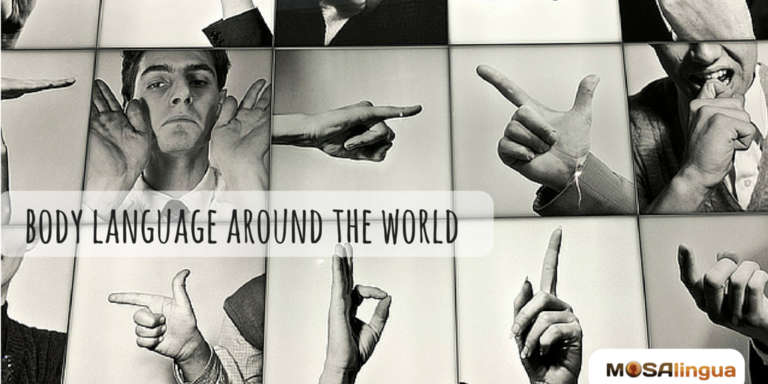It’s well known that we all send messages through body language, however, sometimes it can be easy to forget that each culture has its own gestures. Understanding cultural body language in other countries is key to managing efficient communication, especially when we have not yet mastered a foreign language (have a look at this article about how not to fear talking in another language).
 Gestures and body language refer to how we use non-verbal communication. Nonetheless, body language is not solely based on how we move our body, it also includes:
Gestures and body language refer to how we use non-verbal communication. Nonetheless, body language is not solely based on how we move our body, it also includes:
- Our posture
- Our facial expressions
- How close we are to another person, the personal space between two people and how it varies
- How we move our eyes and whether or not we make eye contact
- How we touch and make use of objects, for example, pens, cigarettes, or clothes
- How we breathe as well as other non-visible physical aspects, such as our heartbeat and how much we sweat
Here is a selection of gestures and their meanings in different cultures. I hope these will help you socialize when you try to communicate with foreigners in spite of the language barrier. Download our free conversation phrasebooks, which will help you easily communicate with foreigners.
Gestures and Body Language in Different Cultures
 Head movements
Head movements
In some parts of India, people tilt their head from side to side to confirm something and demonstrate that they are actively listening. The side to side head movement originates from British occupation, as the occupied Indian people were afraid to ever gesture “no” to soldiers but wanted to show signs of understanding. In occidental countries, we nod in order to affirm. However, in Bulgaria and Greece, nodding actually means the contrary. Don’t forget this important cultural body language if you ever travel to those countries!
Eye contact

Some cultures, such as the Japanese and Finnish cultures, consider constant eye contact awkward. In Caribbean communities, children and teens are taught not to look adults in the eyes when they are being corrected or told off.
In most Western cultures, visual contact when speaking to someone is considered a positive aspect of body language. Strong visual contact is common in Spain and the Arabic culture (among people of the same sex). Not looking back when someone is looking at you is considered disrespectful and demonstrates insecurity, lack of interest or indicates deception.
Hands
The ‘thumbs up’ sign is used in many cultures to mean ‘OK’, in France it can mean number 1. Although, it has a very rude sexual connotation in Islamic countries, Cerdeña and Greece.
Saying goodbye the way Americans do it can be interpreted in some parts of Europe and Latin America as the sign for saying ‘no’.
 Counting with the hands is also different across the world. The Chinese can count up to ten with just one hand, the French start with the thumb and end with the pinky, and Americans start with the pinky and end with the thumb.
Counting with the hands is also different across the world. The Chinese can count up to ten with just one hand, the French start with the thumb and end with the pinky, and Americans start with the pinky and end with the thumb.
The ‘A-OK.’ sign, which is done by touching the tip of the index finger with the thumb thus forming a circle with the last three fingers up means ‘zero’ or ‘nothing’ in France, while some other European countries such as Greece, Italy, Brazil, Turkey and Russia consider it as an insult.
The ‘come here’ sign using the finger is an insult in many Asian countries, as they only do this do pets. It’s important to be aware of slight differences in cultural body language like these!
Greetings and goodbyes
Shaking hands with someone you are introduced to in an informal setting.

Shaking hands is a normal and formal way to greet or say goodbye in Occidental countries. But it’s done in different contexts in different countries. In Romania, for example, only men usually shake hands. And they do it every time they meet, not just the first! It’s not uncommon for men to shake the hands of 20 coworkers when they get to work. In England, however, it’s unusual to shake
Kissing cheeks is something done in many countries, especially in Europe. Though the number of kisses, the occasion for doing so, and which cheek they start off on vary. In Oriental Asia it’s common to bow where as in Southeast Asia both hands are placed together as well (like when praying).
Legs

Sitting with crossed legs is common in North America and European countries, but it is considered disrespectful in Asia and the Middle East where a straight and balanced posture prevails as the norm.
I hope the information on gestures from different countries has sparked a new interest in you to learn more about new cultures. Don’t forget that the MosaLingua apps for language learning are ideal for learning more about a certain culture as well as its language.
The Importance of Body Language Video
For more info on the topic of cultural body language and the importance of body language in communication, check out the video below. You can also watch it on our YouTube channel (by the way, are you already a subscriber?). The video is in English but there are subtitles in 5 other languages if you need them. Just click the gear button in the bottom right corner of the video to turn them on.
Want to tell us more about common gestures in different cultures? Feel free to leave a comment below.
Related posts:
Start learning a new language today
 Did this article make you want to learn one or several languages?
Did this article make you want to learn one or several languages?
Good news: we can help!
More good news: you can get started for free! Start your free trial now and for the next 15 days, take advantage of the most effective language learning method on the market!
Vocabulary flashcards, videos with subtitles, audiobooks, articles adapted to your level – with MosaLingua Premium (Web & Mobile), you’ll have access to all this and more. Get started right now. It’s free—and risk-free—to try!






Body language matters not only while dealing with cross-culture, but also the same culture. In my opinion, I think it is respectful to understand others’ body language culture. Some people offend others using inappropriate way by the excuse that they don’t know the culture. They think they should be forgiven, but they still won’t learn the body language. We are supposed to have reverence for others’ body language. Furthermore, within the same culture, it is still meaningful to concentrate on others’ body language, since we can read others’ minds through body language so that rapport can be built mutually.